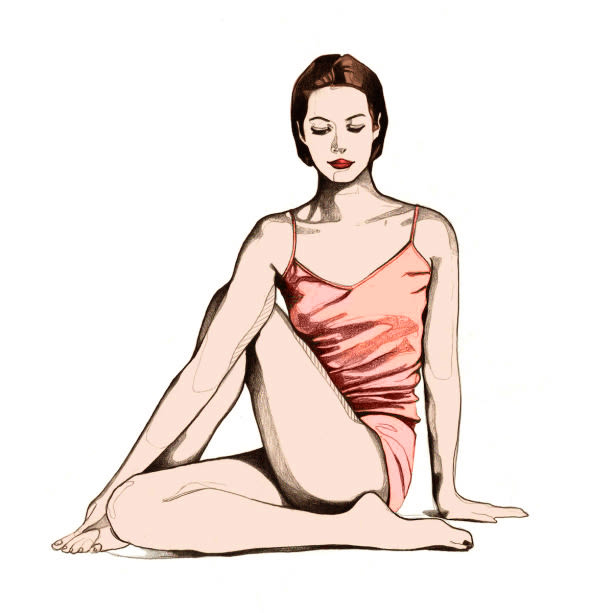This must be what hell feels like.
That was my thought the first time I walked into a hot yoga class. I’m probably going to die. I decided as I made my way to an open spot in the steamy, smelly room. A few minutes later, as the rest of the class calmly worked through their opening breathing series, I started to have a full-fledged freak out. Not more than three minutes had passed and I was already drenched in sweat and halfway through my water supply. This was the end. I was certain.
I survived the 90-minute class (a lot of “corpse” pose was involved) and stumbled out into a sunny summer day, which at a balmy 98 degrees felt almost chilly. I vowed never to subject myself to that kind of torture again and went on my way.
The next day I woke up, so sore I could barely move, with the weirdest feeling. I wanted more. More heat, more sweat, and more of the blissed-out zen feeling that I got when I finished the class. So I went back. And I kept going back for several years.
Now, though I’ve taken my regular practice to an equally vigorous but slightly less scorching form of yoga (shout out to Laughing Lotus Yoga Center), I sometimes still find myself craving the heat.
I’ve always trusted my body to tell me what I should be doing. If something feels bad, I avoid it (other than bikini waxes…still working on a way to steer clear of those). Generally, I advise others to stick to this same habit, but when it comes to hot yoga, the whole “do what feels good” mantra doesn’t totally hold up. It feels crazy to work out in such extreme conditions. Is it dangerous? Will you get hurt? Is it actually a good workout? To put your inquiring minds to rest, I’m dropping all my hot yoga knowledge on you here and now.
First, a very surface-level overview:
**Bikram
**The founder of this particular style isn’t the most popular guy right now, but Bikram is probably still the best-known method to get your sweat on in the yoga world. The room is kept at a strict 105 degrees and 40 percent humidity. Every class is 90 minutes and practitioners always go through the same 26 postures. According to Greg Weglarski, founder of Bikram Yoga Herald Square, the heat is intended to get your blood pumping. “Breathing and increased circulation bring blood to injured or weak parts of the body, allowing them to heal faster,” he says. Devotees like Madonna and Beyoncé give it credit for their killer bodies, too. “Bikram does jump-start digestion,” concedes Weglarski. “But if you’re eating pounds of ice cream every day, good luck to your belly!”
**Baptiste Power Vinyasa
**This method is practiced in a room kept anywhere from 86 to 94 degrees. It is a vinyasa-based class, which means that you flow from one posture to another (cardio!). As Bethany Lyons, founder of NYC studio Lyons Den Power Yoga describes it, the heat allows for deeper physical purification and mental clarity. In other words, it detoxes you and chills you out. Plus, she says, the cleansing effect of the yoga carries over into other aspects of your life, leading you to make healthier food and lifestyle choices (or at least that’s the idea).
To be clear, there are tons of other methods and studios out there that offer their own take on a hot yoga experience. But, those two are a good place to start. Both Weglarski and Lyons subscribe to my same “listen to your body” school of thought when it comes to potential dangers. “Sure, Bikram can be risky if you’re not safe,” says Weglarski. “But so is walking down the stairs or taking a taxi.”
Of course, converts to the practice probably aren’t the least biased people on earth, so I got an expert opinion from Dr. Jordan Metzl, an New York City-based sports medicine guru. According to him, dynamic stretching like yoga is key to any workout regimen. “Yoga is considered moderate exercise,” he explains. “But, since you’re not getting your heart rate up very high, it is not sufficient as a stand-alone practice for improving fitness.”
There has been plenty of talk about the dangers of overheating and the possibility of over-stretching your muscles in the extreme temperature. In response to my concerns about these risks, Dr. Metzl says that, as with any workout, people should relax into the poses and make sure not to push beyond their limits. And centuries of Indian yogis who practice daily, no matter the temperature, would certainly agree. In fact, they would probably argue that air conditioning is the more unnatural phenomenon. To mitigate the risks, Dr. Metzl suggests drinking plenty of fluids—water with electrolytes or coconut water are best—before, during and after the class. To his advice I add: avoid taking class when you are painfully hungover at all costs. It isn’t pretty or fun.
The bottom line? You’ve got to do you. If you know you are the kind of person who hates the heat, hot yoga probably isn’t your workout. I, for one, know I am not the kind of person who likes to imitate the incredible hulk by lifting more than my body-weight in dumbbells, hence my refusal to try CrossFit. Love it or hate it though, the one thing that everyone does agree on is that yoga (hot or not) gives you serious peace of mind. “Many research articles have shown yoga’s potential for reducing anxiety,” says Dr. Metzl. And I feel pretty confident that it’s better for you than Xanax.
—Victoria Lewis
Illustration by Lucy Han.

